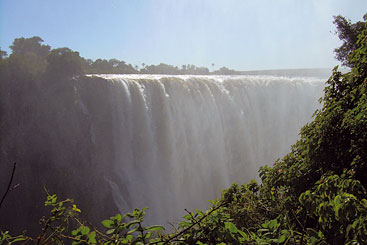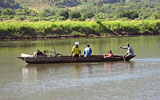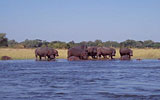
The ICPDR reaches out to the Zambezi Water Commission
The Zambezi River Basin could learn from international commissions as it moves towards operation of the Watercourse Commission.

The Zambezi River Basin supports the Victoria Falls, one of the Seven Wonders of the World.
All river systems are unique, with special treasures and particular problems specific to their region. How those treasures are protected or how obstacles are approached, however, are experiences that river basins can share in order to help achieve similar goals. Recently, the ICPDR has shared its own experiences in river basin management with partners from the unlikeliest of places – Africa.
The Zambezi River is the fourth-largest river in Africa, and the largest flowing into the Indian Ocean. The river flows nearly 3,000 kilometres to drain 1.4 million square kilometres in eight countries. The area is home to about 40 million people and features the spectacular Victoria Falls, the world’s largest waterfalls.
The benefits of involving stakeholders. The 2007 Integrated Water Resources Management Stockholm training programme brought participants from the Zambezi River Basin to support and stimulate the development of Integrated Water Resources Management, and to encourage the participants to get involved with and contribute to networking with other countries. Case studies from the ICPDR and the Helsinki Commission presented in the programme noted that involvement of non-governmental organisations (NGOs) is key to effective operation of the commission, as they are action oriented and can expedite processes.
 Zambezi basin is host
to many wild animals,
including the hippopotamus,
and inhabitants
along the Zambezi River
make a living by offering
transport across the river.
Zambezi basin is host
to many wild animals,
including the hippopotamus,
and inhabitants
along the Zambezi River
make a living by offering
transport across the river.The Zambezi Water Commission (ZAMCOM) could consider engaging NGOs such as IUCN, the World Conservation Union, Southern African Research and Documentation Centre (SARDC) and Global Water Partnership (GWP) to spearhead the process. In addition, establishing an expert group would ensure close cooperation and efficient information exchange between the basin states.
As in the Danube Basin, which is financially supported partly by Coca-Cola and many other business organisations, the Zambezi Basin could also create an environment that would encourage business friends of the Zambezi. Awareness and commitment could also be promoted through establishing The Zambezi Day, The Zambezi Box and The Zambezi Art Master competition, as in the Danube River Basin.
Cooperation in the Zambezi basin. ZAMCOM, which was established to promote equitable and reasonable utilisation of the water resources of the river basin, is expected to support efficient management and sustainable development among the eight riparian states of Angola, Botswana, Malawi, Mozambique, Namibia, Tanzania, Zambia and Zimbabwe.
The commission signed in 2004 by all member states except Zambia, which is still consulting its stakeholders, will come into force when six out of eight countries ratify the commission. As of now four countries have already ratified. Meanwhile an interim committee has been established and a draft document prepared to guide the process of operation.

Finding regional solutions. Key successes of the process are that the region has adopted a benefit approach as opposed to water sharing, to allow those with less water to benefit. There is also national funding of regional initiatives as a result of the commission.
While there has been considerable progress in the process the basin still faces a number of challenges, which if not addressed will stifle the achievements of current efforts. Since the establishment of the commission the region has learnt that lack of mutual trust and confidence among the riparian states, lack of accurate knowledge on the state of water resources within the basin, lack of data harmonisation and verification and lack of information sharing are drawbacks to the commission coming into force. In addition, the bureaucracy involved in accessing required information is cumbersome and there is inadequate funding for water institutions. As a result, data collection has been compromised.
For ZAMCOM to operate meaningfully, it requires essential tools such as the Zambezi Water Information System, and the Integrated Water Resources Management strategy, which would inform the ZAMCOM Strategic Plan.
An important lesson learnt from sharing experiences with other river basins is that the peculiarities of individual riparian states should be recognised in designing interventions to enhance capacity as a way of levelling the playing field.
THE ZAMBEZI
- Length: nearly 3000 km
- Size of basin: 1.4 million sq km
- Countries involved: Angola, Botswana, Malawi, Mozambique, Namibia, Tanzania, Zambia and Zimbabwe
- Inhabitants: about 40 million
- Major tributaries: Lungue-Bungo, Chobe, Shire, Cuando, Kabompo, Kafue, Luangwa, Manyame, Sanyati and Gwayi.
Disclaimer
The information contained in the ICPDR website is intended to enhance public access to information about the ICPDR and the Danube River. The information is correct to the best of the knowledge of the ICPDR Secretariat. If errors are brought to our attention we will try to correct them.
The ICPDR, expert group members, nor other parties involved in preparation of information contained on this website cannot, however, be held responsible for the correctness and validity of the data and information provided, nor accept responsibility or liability for damages or losses arising directly or indirectly from the use of the information conveyed therein.
Only those documents clearly marked ICPDR documents reflect the position of the ICPDR.
Any links to other websites are provided for your convenience only. The ICPDR does not accept any responsibility for the accuracy, availability, or appropriateness to the user's purposes, of any information or services on any other website.
When using the information and material provided on this website, credit should be given to the ICPDR.
